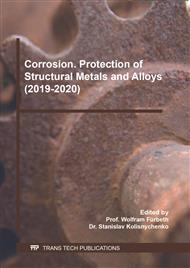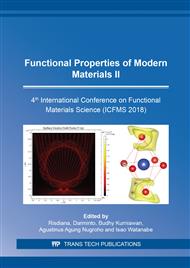[1]
I. Stober, K. Bucher, Geothermal Energy: From Theoretical Models to Exploration and Development, Springer Science & Business Media, (2013).
Google Scholar
[2]
P.F. Ellis, II, M.F. Conover, Materials selection guidelines for geothermal energy utilization systems, NASA STI/Recon Technical Report N 81 (1981).
DOI: 10.2172/6664808
Google Scholar
[3]
H.S. Klapper, R. Bäßler, J. Sobetzki, K. Weidauer, D. Stürzbecher, Corrosion resistance of different steel grades in the geothermal fluid of Molasse Basin, Materials and Corrosion 64 (2013) 764-771.
DOI: 10.1002/maco.201106430
Google Scholar
[4]
M.P. Hochstein, Classification and assessment of geothermal resources, Small geothermal resources: A guide to development and utilization, UNITAR, New York (1990) 31-57.
Google Scholar
[5]
R. Bäßler, A. Keserović, J. Sobetzki, H.S. Klapper, M. Dimper, Materials evaluation for geothermal applications in different geothermal waters, World Geothermal Congress 2015, (2015).
DOI: 10.11113/jt.v75.5164
Google Scholar
[6]
R.W. Revie, Uhlig's Corrosion Handbook, Wiley, (2005).
Google Scholar
[7]
C.G. Munger, L.D. Vincent, Corrosion Prevention by Protective Coatings, National Association of Corrosion Engineers, (1999).
Google Scholar
[8]
K. Belas-Dacillo, A.C. de Leon, A.C.R. Panopio, R.C. Advincula, Evaluating protective coatings and metal alloys in acidic geothermal fluids using laboratory techniques, World Geothermal Congress, (2015).
Google Scholar
[9]
A.J. Dominis, G.M. Spinks, G.G. Wallace, Comparison of polyaniline primers prepared with different dopants for corrosion protection of steel, Progress in Organic Coatings 48 (2003) 43-49.
DOI: 10.1016/s0300-9440(03)00111-5
Google Scholar
[10]
G.M. Spinks, A.J. Dominis, G.G. Wallace, D.E. Tallman, Electroactive conducting polymers for corrosion control, J Solid State Electrochem 6 (2002) 85-100.
DOI: 10.1007/s100080100211
Google Scholar
[11]
A. Keserović, R. Bäßler, Geothermal systems of Indonesia - influence of different factors on the corrosion performance of carbon steel API Q125, World Geothermal Congress, (2015).
Google Scholar
[12]
J.P. Atmojo, R. Itoi, T. Tanaka, M. Fukuda, S. Sudarman, A. Widiyarso, Modeling studies of Sibayak geothermal reservoir, Northern Sumatra, Indonesia, 2000, pp.2037-2042.
Google Scholar
[13]
G.G. Wallace, P.R. Teasdale, G.M. Spinks, L.A.P. Kane-Maguire, Conductive Electroactive Polymers: Intelligent Polymer Systems, Third Edition, CRC Press, (2008).
DOI: 10.1201/9781420067156
Google Scholar
[14]
D. Sazou, C. Georgolios, Formation of conducting polyaniline coatings on iron surfaces by electropolymerization of aniline in aqueous solutions, Journal of Electroanalytical Chemistry 429 (1997) 81-93.
DOI: 10.1016/s0022-0728(96)05019-x
Google Scholar
[15]
U. Rammelt, P.T. Nguyen, W. Plieth, Corrosion protection by ultrathin films of conducting polymers, Electrochimica Acta 48 (2003) 1257-1262.
DOI: 10.1016/s0013-4686(02)00833-2
Google Scholar
[16]
A. Nautiyal, S. Parida, Comparison of polyaniline electrodeposition on carbon steel from oxalic acid and salicylate medium, Progress in Organic Coatings 94 (2016) 28-33.
DOI: 10.1016/j.porgcoat.2016.01.014
Google Scholar
[17]
J. Stejskal, P. Kratochvíl, A.D. Jenkins, The formation of polyaniline and the nature of its structures, Polymer 37 (1996) 367-369.
DOI: 10.1016/0032-3861(96)81113-x
Google Scholar
[18]
G. Mengoli, M.M. Musiani, Protective coatings on iron by anodic oxidation of phenols in oxalic acid medium, Electrochimica Acta 31 (1986) 201-210.
DOI: 10.1016/0013-4686(86)87109-2
Google Scholar
[19]
M.E. Orazem, B. Tribollet, Diffusion Impedance, Electrochemical Impedance Spectroscopy, John Wiley & Sons, Inc., (2008).
Google Scholar
[20]
G. Baril, G. Galicia, C. Deslouis, N. Pébère, B. Tribollet, V. Vivier, An impedance investigation of the mechanism of pure magnesium corrosion in sodium sulfate solutions, J. Electrochem. Soc. 154 (2007) C108-C113.
DOI: 10.1149/1.2401056
Google Scholar
[21]
M.E. Orazem, B. Tribollet, Equivalent Circuit Analogs, Electrochemical Impedance Spectroscopy, John Wiley & Sons, Inc., (2008).
Google Scholar



